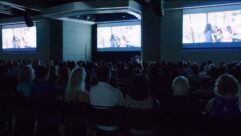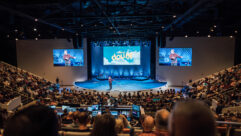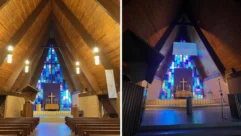
The Buzz: Installation Spotlight: Lakewood Church, Houston
Jun 1, 2008 12:00 PM,
By Bennett Liles
Taming the Monitoring Beast

At Lakewood Church in Houston, Monitor Mixer Danny McVey oversees all monitoring functions using an Aviom system of 16-channel personal monitor mixers connected by Cat-5 cable and used extensively by musicians and vocalists during Sunday services.
The increasingly sophisticated and elaborate performances being done in churches in the past few years have stretched the limits of staging, lighting, and sound. The megachurches have the budget and the AV professionals on staff to handle the rigors of this trend, but the majority of churches have been trying to produce these performances with less-than-front-line equipment and crews of volunteers from the congregation who are long on enthusiasm but short on experience.
One of the most difficult aspects to handle on live musical performances — and one that typically produces the most stinging technical glitches — has been the stage monitoring for the performers. The range of individual preferences among musicians and vocalists, many of whom are visiting with one-time setups, along with the difficulty of maintaining the right configuration and handling the variety of separate mixes needed has strained the crew and their monitoring equipment to keep up.
But two advances in technology have revolutionized the art of stage monitoring — and with dropping prices and advancing capacity, these are making their way into mid-size and smaller churches along with the know-how to use them on the part of the tech crews. Digital audio networks have spread through the house-of-worship AV industry, and they have been applied to stage monitoring in the form of Cat-5 linked digital snakes and personal monitor mixers that take the load off the church sound crew and put the control in the hands of the performers. At the same time, wireless microphones have been joined by wireless in-ear monitoring systems to eliminate cumbersome floor-wedge monitor loudspeakers and the frequent feedback they generate — especially with inexperienced, part-time operators.
It was only natural that among the first implementations of digital audio networks following the introduction of CobraNet and Ethersound would be in the area of stage monitoring, and it’s no coincidence that the megachurches have been among the leaders in applying this digital audio technology to stage monitoring. Danny McVey, the monitor mixer at Houston’s Lakewood Church, oversees all monitoring functions there. Among his equipment is an Aviom system of personal monitor mixers connected on Cat-5 and used extensively by the musicians and vocalists.
“As far as the Avioms, it literally went from a weekend where I was doing everyone’s mix and it was always something, and we put Avioms in on the next service and it was like ducks to water,” McVey says. “It’s a 16-channel mixer you can hand to a musician — and of course, the first thing he goes to is his instrument and cranks that wide open, and then builds everything else around it.”
That’s a particularly critical factor when the architecture and the TV production keeps the monitor mixer out of view and away from what might be considered to be the optimal monitoring position near the performing area. McVey relies on camera monitors and a special loudspeaker system to ride herd on the monitoring from his hideaway.

To maximize RF strength on stage, the crew at Lakewood Church uses special transmitting antennas with wireless Shure PSM 700 personal monitor systems. The Aviom monitor mixers are connected on Cat-5 twisted-pair cable, which is hidden in recessed stage boxes in the floor.
“I’m right next to the stage under a choir riser. And at the old church, my console and everything was in the pit with the band, and it was a stationary pit — didn’t move — and it got to the point that you would know by the way someone looked at you what their problem was, and I would just fix it,” McVey says. “In this room, I’m tucked away by myself, but the band is right outside my back door and I’m looking at a 32in. TV on my desk that’s a four-way split — and three of those four are camera views.”
McVey has a special communication plan with his mixer-equipped musicians. “The band leader at the piano wears a headset microphone with a cough-drop right under his foot so he can turn it on and off,” he says. “He talks directly to me, and I keep one small powered speaker with nothing but his mic in it and that way he can communicate straight to me at any time and I can talk back to him.”
The monitoring system has been augmented to handle the needs of the huge auditorium and to deal with some special challenges presented by Joel Osteen, the charismatic pastor. “We actually use two Aviom systems,” McVey says. “We use an A system and a B system because of the number of people that we have. The A system is basically the rhythm section, and the B system is for brass and strings and anything else that would be extra.”
McVey says he counts one of his advantages as having a technically savvy pastor. “Joel is so technically astute because AV was his background,” he says. “He was doing the television show for his dad before he became the pastor. He doesn’t like the headset mics. That’s just not a comfortable thing for him. The lav is what he likes and because he doesn’t use any monitoring he concentrates on his voice well enough that he’s OK.”
Every Sunday, McVey has a delicate balancing act to do. “The way that affects me is that I have two choir monitors, one on each side, and the choir is on each side of the stage with around 150 people per side looking out the same direction as the pastor, so I’ve got to put his voice up into those monitors enough that the choir people can hear and pay attention to the sermon — but I can’t put too much in there that it gets over to him at center stage, so that’s my biggest challenge,” he says. “And of course being kind of tucked away, I have to preset that, watch for a meter level, and know that I’m about OK on that and then quiz people later to see if it worked for them. It’s not the optimum thing because you’d like to be sitting there, but our setup doesn’t really offer that.”
After the services, McVey talks to the performers about how things went. “Typically, no news is good news,” he says. “As long as everything is OK, everyone is pretty quiet. But if anything isn’t, you’ll surely hear about it and that’s the nature of the monitor business.”
The perfect complement to using the personal monitor mixers is the wireless in-ear monitoring system that sends the customized stereo monitor mixes directly into the ears of the performers and dramatically reduces the amount of ambient sound in the performing area. McVey uses a helical antenna to beam the signals to the performers’ belt-pack receivers and custom-fitted earpieces.
“Most of the musicians have had molds done. They either have the dual drivers and most are E5 quality, but all the musicians have them — unless we have a guest that comes in and I’m just out of ears, someone might have to wear a set of headphones,” McVey says. “That’s something that we picked up at the old church, and everybody tended to like it because everything is a television shot here — you just never know when the camera is going to be on you — so the ears just look so much better than everybody wearing headphones.”

McVey shares his monitoring space with racks of equipment, but he says fan noise does not interfere with his duties come show time.
To maximize the RF strength onstage where it is needed most, a special transmitting antenna is used for the in-ear monitoring system. “The transmitters are right here in the bunker sitting right beside me. They’re mainly just for the packs that are onstage,” McVey says. “We’ve got a helical antenna that’s actually located on the stage now and that’s just for the antenna reception on the ear packs. The one worship leader that uses the Aviom, we have his hooked up into a wireless [Shure] PSM 700 unit, and he’s able to use it just as a control surface to control his mix — but it’s actually affecting a wireless pack.”
The personal monitoring system is a direct application of digital monitoring using Aviom’s A-Net protocol. All the units connect on Cat-5 twisted pair, and this keeps cabling onstage to a minimum. It was intended that way from the start. McVey was also involved in the installation. “Audio Analysts [the Colorado systems integration firm that installed the system] were very clever because they put two Ethernet connections into each stage box. We have a computer-style recessed floor, so all the cabling is hidden real well and we just take one of these Ethernet connections off the snake head and go right to our Aviom control surfaces,” he says. “The only place you see Cat-5 on the stage is where it comes out of the boxes to the back of the nearest control unit.”
The performing area also includes a band pit that raises and lowers 12ft., and there is a front stage that fits a small four- or five-piece band. A couple of snake heads come out of the air vents to go right onto the main stage, and there is an Ethernet line that runs as a pass-through so the team can put another small Aviom system up there sometimes. It keeps the wedges away and provides a much cleaner look. There is also a personal monitor for one of the worship leaders set up right behind the lip of the stage so that he can turn around, reach down, and make adjustments to his own monitor mix where nobody can see him — which makes McVey very happy and gives him one less thing to worry about.
On Sundays, there are three services. One of these is with four-time Latin Grammy Award winner Marcos Witt. Some of his people are speaking Spanish, and because the Lakewood crew members aren’t all fluent in Spanish, they recently patched in the interpreter for this service into their Aviom so the non-Spanish-speaking performers have the ability to follow the sermon, know how it’s going, and know when it’s wrapping up or if they are suddenly asked for something. According to McVey, that’s been a big help. But no stage monitoring situation with live performers is going to be perfect. McVey shares his space with racks of equipment.
“The worst problem with noise in my room is all the fan noise because I’ve got the amp racks and all the other racks in here, and that’s the biggest noise I have in this room,” he says. “But once the show starts, you never think about stuff like that.”
And there are always a few surprises. McVey’s life as the monitor mixer at Lakewood certainly isn’t boring. A host of guest performers and their monitoring demands keep him hopping, but his secret is in maintaining the right attitude.
“The real key for a monitor guy is preparedness,” he says. “If you can know what you’re up against, that sometimes is the biggest challenge because things constantly change no matter how well established you are. Things are always going to happen. Somebody’s always going to walk up and go, ‘Did they tell you that I was going to play guitar today? Did they tell you about the mariachi band coming in here in 10 minutes?’”
One complaint McVey never has is that things are getting dull.
SVC ENEWSLETTERS
- The Briefing Room Extra
- Houses of Worship
- Corporate AV
- Residential AV Presents Connected Home
- AV Over Fiber
- AV in Education
- Digital Signage Update
BREAKING INDUSTRY NEWS IN YOUR EMAIL INBOX EVERY OTHER WEEK! SUBSCRIBE ATWWW.SVCONLINE.COM
INDUSTRY EVENTS
JULY
15-17
E3 Media & Business
Summit
Los Angeles
www.e3summit08.com
22-24
Expo Comm Wireless Japan
Tokyo
www.expocomm.com
FOR A MORE DETAILED LISTING, SEE
DIGITALCONTENTPRODUCER.COM/TRADESHOWSEVENTS










